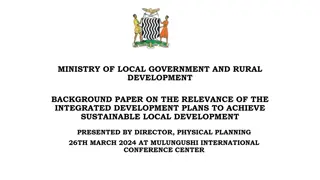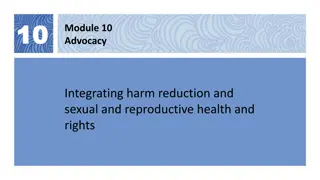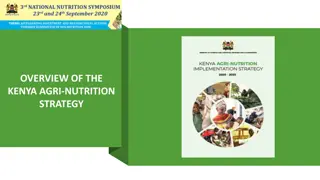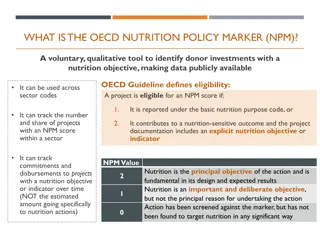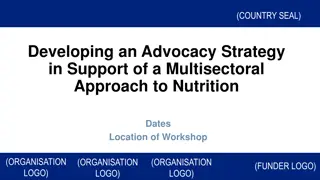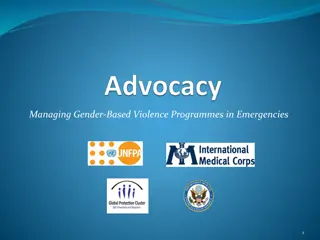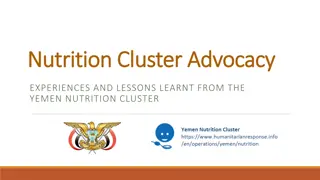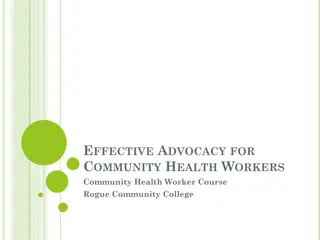District/LLG-Level Nutrition Advocacy Planning Workshop: Day 1 Highlights
Welcome to the District/LLG-Level Nutrition Advocacy Planning Workshop Day 1. Join us as we discuss the purpose of the workshop, engage in introductions, delve into defining advocacy, share experiences, and explore the significance of advocacy in nutrition now. Participants will also set expectations, review the agenda, and engage in a participatory visualization exercise. Together, we aim to develop strategic advocacy approaches and enhance awareness and resources for nutrition initiatives.
Download Presentation

Please find below an Image/Link to download the presentation.
The content on the website is provided AS IS for your information and personal use only. It may not be sold, licensed, or shared on other websites without obtaining consent from the author. Download presentation by click this link. If you encounter any issues during the download, it is possible that the publisher has removed the file from their server.
E N D
Presentation Transcript
District/LLG District/LLG- -Level Nutrition Level Nutrition Advocacy Planning Workshop: Advocacy Planning Workshop: Day 1 Day 1 [Insert date and location]
Session 1 Purpose of the Workshop: Why Advocacy and Why Now?
Introductions Please state your: Name Organization Role Interest in nutrition advocacy
Discussion Questions How do you define advocacy? What are some experiences with nutrition advocacy that you would like to share?
Purpose of the Workshop Develop district/LLG-level multi-sectoral strategic nutrition advocacy approaches that support implementation of multi-sectoral nutrition action plans (MSNAPs) Create talking points for each district/LLG that correspond with the advocacy approach Practice using talking points
Why Advocacy and Why Now? We are using the term advocacy to describe increasing resources and political/social commitment for nutrition. Advocacy is a key component that supports all future communication efforts. Advocacy is essential now to: Create awareness and understanding of the importance of nutrition among the public and within government Ensure adequate resources and structures for nutrition services Increase political action and accountability among government and stakeholders
Expectations What are your expectations during this workshop?
Visualization in Participatory Programmes (VIPP) VIPP allows everyone s voice to be heard. Rules: Include one thought per card Use a marker, not a pen Write with broad side of marker Limit to no more than three lines per card Print legibly
Session 2 National Nutrition Situation and Policy Environment
Nutrition Situation in [insert country]
Session Outline Nutrition situation Consequences of prevailing situation Government priorities: Current initiatives Policy environment Commitments 28 9 14 Percent of children under 5 *Based on the new WHO Child Growth Standards
Malnutrition Prevalence 80 70 60 Percentage 50 40 30 20 10 0 Sources:
Nutrition Situation Underweight
Nutrition Situation Stunting
Nutrition Situation Wasting
Nutrition Situation Iodine deficiency
Nutrition Situation Iron deficiency
Nutrition Situation Anaemia
Nutrition Situation Infant and young child feeding
Session 3 National Nutrition Advocacy Strategies, Materials, and Resources
Uganda Nutrition Advocacy and Communication Strategy
Four Pillars of the Strategy NA & C Strategy Indicators and Outcomes Indicators and Outcomes Pillar 1: Protecting individuals during the first 1,000 days Pillar 3: Promoting positive role models Pillar 2: Promoting healthy Ugandan diets Indicators and Outcomes Indicators and Outcomes Pillar 4: Accountability
Nutrition Advocacy Package Materials developed include fact sheets on: Health and nutrition Agriculture and nutrition Economic productivity and nutrition Education and nutrition Additional materials targeted: Media Civil society organizations Community-based services officers Faith leaders Development partners
Resources Available to Support Nutrition Advocacy: PROFILES
What Is PROFILES? An evidence-based tool to support nutrition advocacy. PROFILES uses computer-based models and current country-specific data to estimate the benefits of improved nutrition on health and development outcomes, and the negative consequences if malnutrition continues over a defined time period. PROFILES estimates are intended to support nutrition advocacy efforts targeting multiple audiences (e.g., communities, local government authorities, parliamentarians).
General Assumptions of PROFILES PROFILES requires: Current prevalence of nutrition indicators Mortality rates Projected population estimates Assumptions about targets for improvement in nutrition Time period for the estimates The PROFILES model assumes a steady linear reduction in the prevalence of nutrition problems from the starting point until the end of the specified time period.
Example: The Approach Used in PROFILES to Calculate Estimates Figure B. Improved scenario Figure A. Status quo scenario Figure C. Both scenarios
Nutrition Problems Addressed in PROFILES and the Benefits of Their Reduction
Prevalence, Data Sources,* and Targets Indicator 2012 Prevalence 2025 Target Moderate and severe underweight (0 59 months) 13.8 8.3 Moderate and severe stunting (24 35 months) 42.7 25.6 Moderate and severe stunting (0 59 months) 33.4 20.0 Moderate and severe wasting (0 59 months) 4.7 3.5 Population 6 59 mos. with vitamin A deficiency 32.6 13.0 Population with goitre 5.0 3.0 Pregnant women with anaemia 30.6 16.8 Nonpregnant women 15 49 years with anaemia 22.1 12.2 Men 15 49 years with anaemia No data No data Low birthweight 10.2 7.1 *The UDHS 2011 was the source of information for all indicators in this table, with the exception of goiter. Because there is no recent information, the goiter prevalence was the same as that used in the Uganda PROFILES 2010.
Lack of Change in Stunting Prevalence: Annual Number of Stunting-Related Deaths Will Rise Due to Children Under-5 Population Increase 40000 35000 Number of under-5 deaths 30000 25000 Mild 20000 Moderate Severe 15000 10000 5000 0 2013 2014 2015 2016 2017 2018 2019 2020 2021 2022 2023 2024 2025
Nutrition Improves and Stunting Prevalence Reduced: Annual Number of Under-5 Lives Saved 35000 In the period 2013 2025, ~88,000 deaths related to stunting could be averted 30000 Number of under-5 deaths 25000 20000 Mild Moderate 15000 Severe 10000 5000 0 2013 2014 2015 2016 2017 2018 2019 2020 2021 2022 2023 2024 2025
No Change in Wasting Prevalence: Annual Number of Wasting-Related Deaths Will Rise Due to Children Under-5 Population Increase 25000 Number of under-five deaths 20000 15000 Mild Moderate 10000 Severe 5000 0
Nutrition Improves and Wasting Prevalence Is Reduced: Annual Number of Under-5 Lives Saved 18000 In the period 2013 2025, ~31,000 deaths related to wasting could be averted 16000 Number of under-five deaths 14000 12000 10000 Mild 8000 Moderate 6000 Severe 4000 2000 0
Continuation of Current Nutrition Situation: Number of Deaths and Disabilities Status Quo Scenario 2013 2025 Maternal deaths Perinatal deaths Infant deaths Child deaths Child deaths Child deaths Permanent disabilities VAD IDA IDA LBW IDD Stunting Wasting 1.1 221,000 9,800 70,900 196,000 232,000 422,000 million
Saving Lives and Preventing Disabilities, 2013 2025 Maternal deaths averted Perinatal deaths averted Infant deaths averted Child deaths averted Permanent disabilities averted* *Cretinism and mild- to-severe permanent brain damage prevented LBW IDA IDA VAD IDD 4,400 19,800 25,800 60,900 236,500
Economic Productivity Losses if the Current Nutrition Situation Continues 9,000 8,000 7,000 6,000 US$ (Millions) Stunting US$7.7 billion 5,000 4,000 3,000 2,000 Iodine deficiency US$363 million Anaemia US$454 million 1,000 0
Economic Productivity Gains by 2025 from Reducing Stunting, Iodine Deficiency, and Anaemia 1,800 1,600 1,400 1,200 US$ (Millions) Stunting US$1.7 billion 1,000 800 600 400 Anaemia US$108.8 million Iodine deficiency US$75.9 million 200 0
Conclusion Nutrition is central to development for Uganda. Investment in nutrition is needed to achieve further gains in the economic growth and Sustainable Development Goal (SDG)/World Health Assembly goals/targets. Investing in nutrition is critical because implementation of evidence-based, effective nutrition interventions can result in several improved key development outcomes: Improved child development, cognitive function, and educational outcomes Increased economic productivity Women s and children s lives saved
Session 4 Multi-Sectoral Nutrition Action Plans and Advocacy Needed to Support Those Plans





